- 1st International Endocrine Disruptor Conference on the Island of Ireland - PROTECTED
- 5th IFAC Conference on Intelligent Control and Automation Sciences
- 8th European Conference on Weaning and Rehabilitation in Critically ill Patients
- Acts of Union: Mixed Marriage in Modern Ireland
- Advanced Composites Research Group
- AFBI Library Online
- Animal Research
- Ballyhanna
- Belfast Eye Conference
- Belfast Young Archaeologists' Club
- Brexit NI
- Brian Friel Theatre
- Campus Food and Drink
- Cancer Caring Coping
- Career Opportunities at Queen's
- Cell Therapy Facility
- Centre for Community Archaeology
- Centre for Intelligent Autonomous Manufacturing Systems
- comhra
- Connect
- ContactVIRT: Intergroup Contact in Virtual Reality
- Control 2016 - 11th International Conference on Control
- Core Technology Units
- Cycle Plus
- Dentistry
- Early Mining in the Lower Segura Valley, SE Spain
- EFACIS 2023 (European Federation of Associations and Centres of Irish Studies)
- ENGINE
- Eye Surgery Robot
- Fiber Reinforced Polymer for Reinforced Concrete Structures 14
- FRAGSUS
- Frank Ryan
- Friel Reimagined
- Functional Nanocomposite Research
- Game of Stones
- Graduate Support
- GroundsWell
- HaBio
- Heritage Hub
- ICBBM2019 International Conference on Bio-Based Building Materials
- If I Were Jack
- Immigration Support Service
- Inclusion Really Does Matter
- International Conference on Livestock, Companion Animals and Wildlife Coronaviruses
- Involve FP
- iRISE
- Irish Plant Scientists’ Association Meeting (IPSAM)
- KN Cheung SK Chin InterSim Centre
- MAD4VISION
- Mental Health Awareness Week
- MiniPublics
- mistral
- NICOLA
- Northern Ireland High Performance Computing
- Northern Ireland Public Data Panel
- Northern Ireland Technology Centre
- OLIVER Project
- Open Learning
- Palestinian Bedouin at Risk of Forced Displacement
- Participation for Protection (P4P)
- Patient and Carer Education Partnership
- Photovoice Project
- Political Studies Association of Ireland (PSAI) Annual Conference 2023
- Post Operative Delirium Belfast (PODB)
- Post-Brexit Governance NI
- Postdoctoral Development Centre
- PRISM LGBT+ Staff Network
- Professor Chris Allen Hannibal The New Evidence
- PROMED-COG
- Protected EU
- Q-PreMan
- QUBeWell
- QUBGP
- Queen's AFBI Alliance
- Queen's Communities and Place
- Queen's Formula Racing
- Queen's Gender Initiative
- Queen's Students' Union
- Rare Disease Focus: supporting rare disease throughout all communities
- Reading Together
- Reducing Car Dependency in Belfast
- SANDWICH
- Science and Culture Research Group
- Smart Manufacturing & Robotics Research Group
- Staff Excellence Awards
- Staff Gateway
- STAYin(g)Rural
- Stride
- student partnership
- Suicide Prevention Research and Impact Network (SPRIN)
- Summer Scheme
- Taxonomy and phylogeography of the Arctic char in Ireland
- Queen's University Technicians
- The British Legal History Conference 2022
- The Genius Network
- The Healthcare Library of Northern Ireland
- The Northern Ireland Assembly Election Study 2016
- The Northern Ireland Network for Trials Methodology Research
- Training in Cancer Mechanisms and Therapeutics
- UK China Universities Consortium on Engineering Education and Research
- UK Paediatric Delirium Group
- Ulster Archaeological Society
- Unique-Check
- vWa Project
- Web Support Team
- Women's Epistolary Networks
- Media Lab
- Queen's on Pregnancy Loss
- 20 MPH Speed Limits
- Advanced Manufacturing Innovation Centre
- Ageing in Literature: Global South and Global North Perspectives
- Co-Centre for Climate + Biodiversity + Water
- Emerald Isle Conference on Sustainable Chemistry and Engineering
- ENSGOV
- InQUBate: Supporting Student Innovation and Enterprise
- Intercultural Virtual Home
- IReach Health
- Lagomorph 2024
- Momentum One Zero
- NI Grad Fair 2025
- Northern Ireland Landscape Partnership in AI for Bioscience
- Occupational Health
- Predictive Sports Analytics
- Translating Age
- WHO Collaborating Centre
Early Mining in the Lower Segura Valley, SE Spain
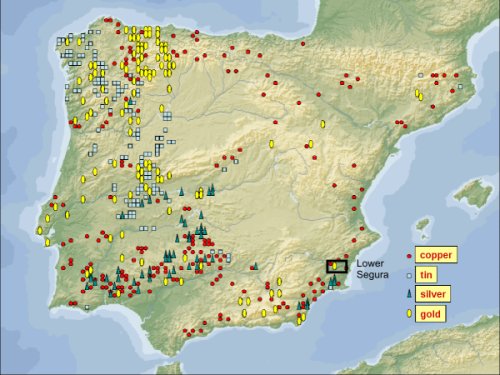
Distribution of major ore bodies in the Iberian Peninsula (modified from
Bartelheim 2007, fig II.7)
Except for the transition from a hunter-gatherer to a farming economy, the introduction of metallurgy is perhaps the most transformative development experienced by prehistoric societies, both in economical and societal terms. Among the various factors underpinning this process, changes in mining technology on the one hand and in the social organization of mining activities on the other both play a crucial role.
Ideally, technological and societal aspects of early mining should thus be studied in conjunction, to allow for a fuller understanding of how and why different communities adopted metallurgy at different times, under different circumstances and not always with the same consequences.
In most instances, however, evidence for the study of both the technological and the societal side of early mining is not readily available in equal measure. Rather, availability of adequate data on prehistoric ore extraction and processing sites, settlements and corresponding burial grounds from the same micro-region is the exception rather than the rule.
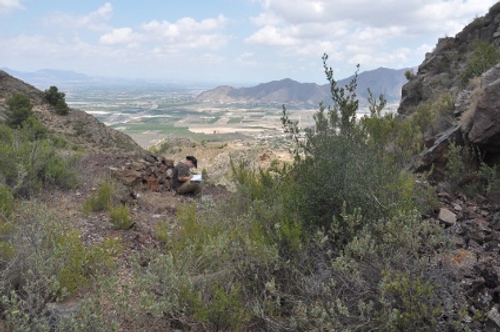
Recording an extraction site in the Sierra de Orihuela
This also applies to the Iberian Peninsula, despite of its abundant and varied mineral deposits, some of which were exploited at least since the 4th millennium BC. While its most prominent Chalcolithic (Los Millares) and Earlier Bronze Age (El Argar) cultures are centred in the Southeast, where copper minerals are also present locally, efforts to identify archaeological evidence for prehistoric mining have mostly focused on the particularly mineral-rich northern and western parts of Iberia.
Attention in the Southeast so far has concentrated almost exclusively on the remains of Punic and Roman mining activity around Cartagena. It comes as no surprise then that there is currently no evidence for ore extraction from south-eastern Iberia predating the later 1st millennium BC.
The lack of any earlier evidence has generated some debate on the potential reliance of 3rd and 2nd millennium communities in the Southeast on imported metal and the socio-economical implications of such a dependence. The question needs to be asked, however, whether the absence of any earlier evidence here is indeed to be taken as evidence of absence, given that very little systematic survey work has been conducted so far to locate traces of prehistoric mining activity in the region.
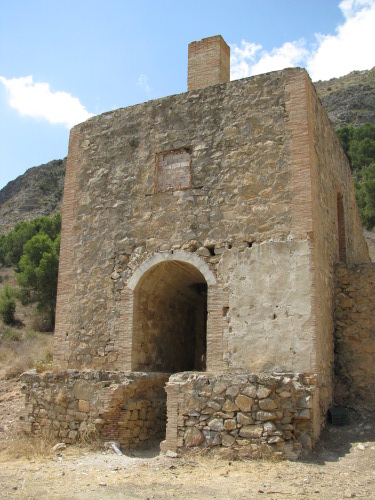
19th century mercury furnace
Reasons for this state of affairs are varied. Generally, any attempt at identifying relevant evidence requires initial recording of all mining-related remains in a given survey area, regardless of date. Even based on a full body of survey data, at sites with a complex history it can still prove rather difficult to identify traces of prehistoric mining activity among later remains. Good knowledge of local ore bodies is also essential for an effective survey. Remote-sensing techniques tend to be of limited use in attempts to identify prehistoric mining remains, and the terrain often does not lend itself easily to standard walk-over techniques.
In light of those issues it was felt that in order to develop a coherent strategy for addressing the questions at hand, a pilot survey should be conducted in a limited area with both a known history of copper mining and evidence for prehistoric settlement.
Based on these criteria, we chose the sierras bordering the Lower Segura valley for our initial survey area, focusing particularly on the Sierra de Orihuela and Sierra de Callosa, situated on the border between the modern-day provinces of Alicante and Murcia.
Previous research here had identified both a significant number of settlement and burial sites dating to the 3rd to 1st millennia BC as well as the presence of copper ores easily accessible to prehistoric miners. Historical records attest to the exploitation of copper, iron and gold in the area during the post-medieval period, and the slopes of the Sierra de Orihuela are dotted with abandoned mine shafts and spoil tips.
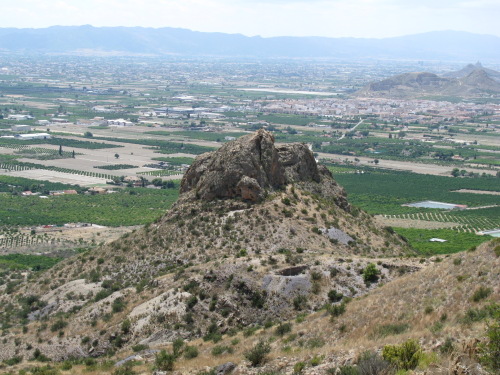
Modern shafts and spoil tips at the Cabezo de la Mina
The primary objective of our two pilot survey campaigns in 2010 and 2011 has been to compile a database of all surviving mining remains in the Sierra de Orihuela and Sierra de Callosa, regardless of their date, and to systematically collect copper ore samples from relevant sites for minor-element and lead-isotope analysis.
So far, more than a hundred extraction-related sites have been catalogued, from small exploratory open-cast pits to complex systems of shafts and galleries, and a substantial number or ore samples have been collected. Most of the surveyed sites date to the 19th and 20th centuries AD, but an iron mine of Later Iron Age or Roman date and a prehistoric basalt extraction pit have also been identified.
Direct evidence for prehistoric copper mining is still lacking, but given the scale of later mining activities in the area it would not come as a complete surprise if any traces of Chalcolithic or Early Bronze Age ore extraction had since been obliterated.
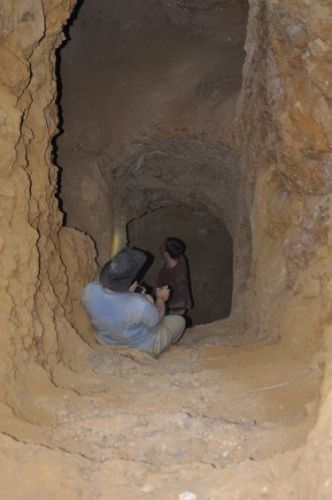
Surveying a Roman shaft
The lack of direct evidence for prehistoric copper ore extraction notwithstanding, some of the data gathered over the course of our project would seem to indicate that copper was indeed mined in the area during prehistory. Our 2011 survey campaign has yielded clear indication of ore processing at an Early Bronze Age settlement on the aptly named Cabezo de la Mina. While one cannot rule out the possibility that the copper ore processed at this site might have come from further afield, long-distance import of copper mineral to a settlement sitting right on top of a major and easily accessible ore body seems unlikely.
Apart from mining-related sites, our survey has also identified a number of other archaeological remains that had not previously been recorded. In chronological terms these range from later prehistory to the post-medieval period and include a range of different types of site, complementing our existing knowledge of settlement patterns in the study area.
Concerning future work, while the 2010 and 2011 campaigns have already yielded a large body of information, some parts of the study area are still in need of more intensive survey. In order to enhance the chronological resolution of our GIS-based analysis of settlement patterns, we are also planning to open test trenches at selected sites to acquire relevant stratigraphical data.
Additional data are also required to address the issue of raw material provenance for Chalcolithic and Bronze Age metalwork from the study area. Forthcoming analytical results from our ore sampling programme will for the first time allow for comparison between local copper minerals and finished objects in terms of minor-element composition. The existing body of minor-element data from metalwork with a secure local provenance is rather limited, however, and no lead-isotope data are currently available. Hence, in 2012 we undertook a sampling campaign of locally provenanced museum objects kept at the Museo Arqueológico Comarcal de Orihuela and Museo Arqueológico de Alicante in order to fill this lacuna. Analysis of the respective data is currently underway.
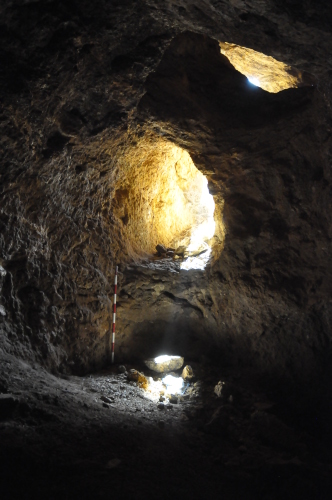
Modern works cutting into a Roman gallery
Besides these strictly scientific objectives, our project is also taking an active role in efforts by Orihuela council to foster green tourism in the area, informing their strategy to raise awareness of the Sierra de Orihuela’s mining heritage and developing a concept to integrate some of the more prominent sites recorded by our survey in sign-posted walks, while restricting public access to unsafe mines.
The project team includes researchers from Queen's University Belfast, Ruhr-Universität Bochum, the Freiburger Institut für Paläowissenschaftliche Studien, Museo Arqueológico Comarcal de Orihuela and Universidad de Murcia.
We would also like to acknowledge crucial IT support from ArchGate project staff, who never lost their nerve in trying to respond – mostly on very short notice – to what must have appeared to them some quite bizarre requests to tailor the ArchGate software to our outlandish project needs.
Funding for the project was kindly made available by the British Academy from its Albert Reckitt Archaeology Fund.
Please click here for a preliminary note on the 2010 campaign, published in the Prehistoric Society's newsletter PAST (# 67, April 2011).
Further interim reports
D. Brandherm and A. Maass 2010. 'Copper mining, settlement and society in the Earlier Bronze Age of southeast Spain: prospects for new research in the Lower Segura valley', in: Mining in European History and its Impact on Environment and Human Societies – Proceedings for the 1st Mining in European History Conference of the SFB-HIMAT (12–15 November 2009, Innsbruck). Innsbruck, Innsbruck University Press, 17–22.
D. Brandherm, A. Maass and E. Diz Ardid 2013. 'Multi-period mining remains from the Sierra de Orihuela (Alicante, SE Spain)', in: Mining in European History and its Impact on Environment and Human Societies – Proceedings for the 2nd Mining in European History Conference of the FZ HIMAT (7–10 November 2012, Innsbruck). Innsbruck, Innsbruck University Press, 115–119.
D. Brandherm, A. Maass, M. Müller-Kissing and E. Diz Ardid 2014. 'Prospecciones arqueomineras en la Sierra de Orihuela', in: Orihuela, arqueología y museo. Museos municipales en el MARQ. Alicante, Museo Arqueológico de Alicante, 114–125.
D. Brandherm, I. Montero Ruiz, M. Müller-Kissing, A. Maass and E. Diz Ardid 2022. 'Copper Supply Networks in the Early Bronze Age of South-east Spain: New Evidence from the Lower Segura Valley', Interdisciplinaria Archaeologica 13 (2): Online First
E. Diz Ardid, D. Brandherm, A. Maass and M. Müller-Kissing 2010. 'El horno de calcinación de cinabrio de “Santa Matilde”, San Antón (Orihuela)', Cuadernos de Historia y Patrimonio Cultural del Bajo Segura 3, 107–110.
Information released to the local press release following our 2011 campaign is available at the following URL:
http://www.laverdad.es/alicante/v/20110721/orihuela/patrimonio-estudia-puesta-valor-20110721.html